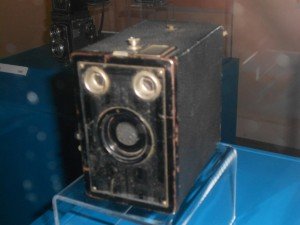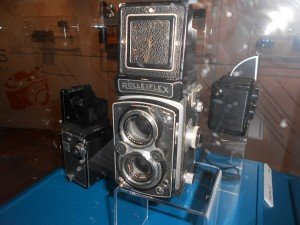Similar to all technology, the camera kept evolving and improving with years. Trips Into History visited several exhibits of vintage cameras that we found quite interesting.
Thank you for reading this post, don't forget to subscribe!Cameras have a history beginning with the direct positive made in the camera on a silver copper plate. This was called a daguerreotype. This was the first commercial photographic process. Today of course we have the highly advanced digital process.

Many different cameras and processes were introduced through the decades and we wanted to present just a few of them. Below are several vintage and classic cameras we found particularly interesting.
The Blair Stereo Weno
The Blair Tourograph Company was founded in Connecticut in 1878 by an immigrant from Nova Scotia. The tourograph camera was based on the wet plate system. The collodion process (wet plate) produced a negative image on glass. The developing of this process usually had to be done within fifteen minutes which meant that it wasn’t great for field work photography unless you carried a portable dark room along. The reason the process had to be done so quickly was that the wet plate still needed to be wet. If the plate dried you were out of luck. It’s advantages were it’s excellent photographic detail. It’s disadvantages were the time constraints mentioned above plus some trouble with chemical staining.

The Blair Tourograph Company like several other early camera companies were bought out by Eastman Kodak. In the case of Blair’s this occurred in 1899. The first of the Blair Stereo Weno cameras came on the market in 1901 after Eastman had acquired the company. Although the company was owned by Eastman Kodak, the Blair cameras still carried the Blair name for several years.
The stereo camera like the one shown above is a stereo camera because it has two lenses. The spacing between the two lens is about the same as with a human’s two eyes. Some stereo cameras were built with more than two lenses. Because the camera essentially operates similar to a human’s vision, it’s able to capture three-dimensional images. The camera lenses folded up into a case which made it very easy to carry.

1934 Eastman Kodak Brownie Junior
George Eastman introduced the first simple camera to the public in 1888. Eastman’s original camera came preloaded with a 100-exposure roll of flexible film. After finishing the roll, the camera’s owner mailed the camera back to the factory to have the prints made.
Over the next century Kodak cameras made taking pictures affordable and simple. The Kodak cameras were low cost and put a good camera into the hands of non-professionals.
The first Brownie camera was introduced by Eastman Kodak in 1900. The camera itself cost one dollar. It was manufactured in a black leatherette covered box.
The film included with the camera price was six exposure. When you purchased more film the cost was only 15 cents per roll. Eastman produced many different cameras through the 1900’s and many varieties of film. The camera shown in this article is the 1934 Brownie Junior.
The Kodak Brownie models had a long run and more than anything they introduced the public to low cost photography. The Brownie was meant for taking snapshots. It was immensely popular. The Kodak Brownie cameras were simple to use. The Kodak slogan was…”You Press the Button, We do the rest“.

1951 Rolleiflex Twin Lens
The Rolleiflex twin lens is a high end camera. Their first camera was introduced in 1929 as the first medium format film roll camera. The camera shown here is a vintage 1951 Rolleiflex Automat 6X6 K4A twin lens reflex camera made by Franke & Heidecke of Germany. It’s a very popular collector’s camera. The Rolleiflex camera was noted for bright accurate reflex viewing and smooth focusing. The reflex camera uses both a reflected image from the camera’s lens and a viewfinder image. In the twin lens camera, one lens is used for actually taking the picture while the other lens is used for the viewfinder.
You will also enjoy our Trips Into History article on the Norden Bombsight that was crucial during World War Two.
See Vintage Cameras
There are a number of interesting museums around the United States that exhibit vintage and classic cameras. You may want to add some of these to your next road trip planner. Many vintage and classic cameras are in private collections and when you have an opportunity to visit a public camera museum it can be a rare adventure.
The Camera Heritage Museum– Located in Staunton Virginia, this museum houses a unique collection of antique cameras dating from the 19th century to modern times.
The Smithsonian National Museum of American History– Located in Washington D.C., the museum collects and preserves more than 3 million artifacts of American history. Here you’ll find some of the first Kodak cameras manufactured by George Eastman.
The National Cowboy and Western Heritage Center– Located in Oklahoma City Oklahoma, this very large museum shows everything cowboy and western. Included in the museum is a frontier exhibit with a photographers shop of the era. There you will also find a good collection of classic and vintage cameras.
UCR/ California Museum of Photography– This museum is part of the University of California Riverside “Artsblock.” Located in downtown Riverside California, ARTSblock is composed of the California Museum of Photography, the Sweeney Art Gallery, and the Barbara and Art Culver Center of the Arts. A large collection of classic and vintage cameras are on display.
(Photos from author’s collection)
